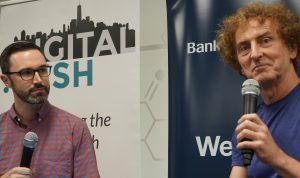
When Board Member Gavin McMahon greeted the Digital Irish attendees at Bank of Ireland’s Innovation Labs, it was a coming back to base after a complicated summer and long weekend; it felt a little like getting back on track.
Booked on September 11th — a peculiar date for any NYC calendar — the first event of the new season nonetheless, the occasion seemed less on people’s minds than you’d think. Connecting and sharing common ground, was more the matter at hand; it was a great place to spend over an hour discussing one serious success story.
A non-profit located in NYC, Digital Irish’s goal is to promote Irish startups by highlighting them, providing access to resources and networking opportunities. Such fields as social media, mobile, online advertising, and analytics get the spotlight and opportunities for expansion. Founded by Feargall Kenny in 2013, #NYDI has grown to over 2000 members and more than 100 startups having presented their stories so far.
To start the night off, MacMahon hosted a fireside chat with SOSV founder and Managing Partner Sean O’Sullivan and then featured three Irish startups/scale-ups: ParkPNP, Umba, and FundRecs.
McMahon himself has a resume that makes him a valuable member. Prior to his NYC move, this Santander healthcare banker consulted with startups as well as work with Irish-based companies. Once here, he managed acquisitions regionally for a NYC-based PE group. He also was a Product Consultant/Support Specialist at Pioneer DJ and ran several small businesses, at various stages, in both an online and offline setting. A two-time graduate of University College, Cork, McMahon sold all his stuff, packed his bags and hit NYC’s shores in September 2014. Within four days, he attended his first Digital Irish event.
As for O’Sullivan, he created his accelerator-based venture capital firm after years of start up successes. A perfect role model for this knowledgeable audience, SOSV runs one of the world’s most active accelerators in hardware, life sciences, disruptive food, and Asia cross-border startups with over $650M in assets under management. O’Sullivan got his start as co-founder and chairman of MapInfo, bringing street mapping technology to personal computers. MapInfo became a $200 million public company with over 1,000 employees.
As he recalled, “I was 21 when I started my company and 19 when I started at IBM. What I did was say, ‘Okay, what could you do with this limitless data storage of about 650 MB?’ Now it doesn’t seem like that much but back then it was massive because the hard drives back then were 5 MB, which is like, a single picture on your iPhone. So, I figured out a way where you could put all the street maps of the entire United States, if you had them all, on one CD Rom. We came up with some really spectacular ways in both compressing the data and displaying it super super fast. We were the first to do that in the world.”
He continued with a chuckle. “During college — in order to pay for college — I took six months off so I could go work for IBM to earn some money and then I’d go back to University. While I was at IBM, I was working on electrical engineering projects and discovering some of the things that were coming out. At the time, CD Roms were coming out — this was a long time ago.”
Out of that he learned, “It was a combination of the different technologies that were available, really I was thinking like a technologist and just trying to find applications for it. I found that given the trends in technologies, I was combining three different cutting-edge technologies and recognizing that if you push the edge on each of those different technologies, then basically you would be the best in the world because you would be the only person in the world doing it. That’s how I always advise startups, is to choose a niche that’s so small that you dominate it.”
Then with the next company, NetCentric in 1996, he and Compaq’s George Favaloro co-coined the term “cloud computing.” As he explained, “Taking something that exists and making it obsolete is something I did with Netcentric, and we made software for inside the internet. The internet at that time was just a communications protocol. So, we thought, ‘What would happen if you put the software inside the internet? Okay, let’s call it Cloud Computing.’ That company, actually, didn’t do that well, but I invested in several other companies along the way in that whole cloud computing space, and those did well.”
On the humanitarian side, Sean has created and/or supports a range of humanitarian and educational endeavors, including JumpStart International, CoderDojo, Mathletes, I-ASC, and Khan Academy. “It is so empowering to be an engineer because you can create things that have massive impacts. We live in a very unique time where an engineer can actually have an impact on hundreds, millions, even billions of people with the products that they design.”
As O’Sullivan realized, “I’m 55 years old now and I love creating. There is nothing quite like being an engineer and being creative. Everyone always thinks that only being an artist is creative.”
In doing so,he concluded. “I think the only way to be successful as an entrepreneur is to be of service to others. If you have that as a core value of your life, being useful to others, then people want to buy your products. Then you actually have a business model that is sustainable. There are multiple ways of running a business. You can create value, which is the of service to others approach, or you can extract value. Extracting value is a reasonable model for some businesses, but I’m always looking at trying to create more value than we’re charging for.”
